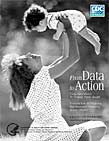 |
|
From Data to Action: References |
|

Using Surveillance To Promote Public Health
Examples from the Pregnancy Risk Assessment Monitoring System (PRAMS)
EXECUTIVE SUMMARY PUBLICATION YEAR 2002
References
-
 Committee
on Unintended Pregnancy, Institute of Medicine, National Academy of
Sciences. (1995). The Best Intentions: Unintended Pregnancy and the
Well-being of Children and Families. Washington, DC: National Academy
Press. Committee
on Unintended Pregnancy, Institute of Medicine, National Academy of
Sciences. (1995). The Best Intentions: Unintended Pregnancy and the
Well-being of Children and Families. Washington, DC: National Academy
Press.
- U.S. Public Health Service. (1991). Healthy People 2000: National
Health Promotion and Disease Prevention Objectives. (DHHS Publication
No. PHS 91-50212). Washington, DC: U.S. Department of Health and Human
Services, Public Health Service.
- Wilcox LS, Marks JS. (1994). From Data to Action: CDC’s Public
Health Surveillance for Women, Infants, and Children. CDC maternal and
child health monograph. Atlanta, GA: Centers for Disease Control and
Prevention.
- Mainous AG 3rd, Hueston WJ. (1994). The effect of smoking cessation
during pregnancy on preterm delivery and low birthweight. The Journal
of Family Practice, 38(3): 262–266.
-
 Hellerstedt
WL, Pirie PL, Lando HA, Curry SJ, McBride CM, Grothaus LC, Nelson JC.
(1998). Differences in preconceptual and prenatal behaviors in women with
intended and unintended pregnancies. American Journal of Public Health,
88(4):663–666. Hellerstedt
WL, Pirie PL, Lando HA, Curry SJ, McBride CM, Grothaus LC, Nelson JC.
(1998). Differences in preconceptual and prenatal behaviors in women with
intended and unintended pregnancies. American Journal of Public Health,
88(4):663–666.
- Altfeld S, Handler A, Burton D, Berman L. (1997). Wantedness of
pregnancy and prenatal health behaviors. Women and Health,
26(4):29–43.
- Kost K, Landry DJ, Darroch JE. (1998). Predicting maternal behaviors
during pregnancy: does intention status matter? Family Planning
Perspectives, 30(2):79–88.
- Rochat RW, Brantley M, Floyd V, Norris D, Franko E, Blake P, Toomey K,
Fernhoff P, Zeigler B, Mayer L, Henderson O, Hannon H, Martin L, Ferre C.
(1997). Prevalence of perinatal exposure to cocaine in Georgia, 1994. Georgia Epidemiology Report, 13(2):1–3.
- Eggleston E, Tsui AO, Kotelchuck M. (2001). Unintended pregnancy and
low birthweight in Ecuador. American Journal of Public Health,
91(5):808–810.
-
 Fried
PA. (1993). Prenatal exposure to tobacco and marijuana: effects during
pregnancy, infancy, and early childhood. Clinical Obstetrics and
Gynecology, 36(2):319–337. Fried
PA. (1993). Prenatal exposure to tobacco and marijuana: effects during
pregnancy, infancy, and early childhood. Clinical Obstetrics and
Gynecology, 36(2):319–337.
- U.S. Department of Health and Human Services. (2000). Healthy
People 2010 (Conference edition, in two volumes). Washington, DC: U.S.
Department of Health and Human Services, Public Health Service.
- Chomitz VR, Cheung LW, Lieberman E. (1995). The role of lifestyle in
preventing low birth weight. Future Child, 5(1):121–138.
- American Academy of Pediatrics Committee on Environmental Health.
(1997). Environmental tobacco smoke: a hazard to children. Pediatrics,
99(4):639–642.
- Windsor RA, Woodby LL, Miller TM, Hardin JM, Crawford MA, DiClemente
CC. (2000). Effectiveness of Agency for Health 18 Care Policy and Research
clinical practice guideline and patient education methods for pregnant
smokers in Medicaid maternity care. American Journal of Obstetrics and
Gynecology, 182(1 Pt 1):68–75.
-
 American
College of Obstetricians and Gynecologists (ACOG). (1989). The Battered
Woman (Technical Bulletin No. 1240). Washington, DC: ACOG. American
College of Obstetricians and Gynecologists (ACOG). (1989). The Battered
Woman (Technical Bulletin No. 1240). Washington, DC: ACOG.
- Pearlman MD, Tintinalli JE, Lorenz RP. (1990). Blunt trauma during
pregnancy. New England Journal of Medicine, 323(23):1609–1613.
- Sammons LN. (1981). Battered and pregnant. American Journal of
Maternal Child Nursing, 6(4):246–250.
- Locksmith GJ, Duff P. (1998). Preventing neural tube defects: the
importance of periconceptional folic acid supplements. Obstetrics and
Gynecology, 91(6):1027–1034.
- Ray J, Laskin C. (1999). Folic acid and homocyst(e)ine metabolic
defects and the risk of placental abruption, pre-eclampsia and spontaneous
pregnancy loss: a systematic review. Placenta, 20:519–529.
- Hall JG, Solehdin F. (1998). Folate and its various ramifications.
[Review] Advances in Pediatrics, 45:1–35.
-
 Centers
for Disease Control and Prevention. (1996). Guidelines for death scene
investigation of sudden, unexplained infant deaths: recommendations of the
Interagency Panel on Sudden Infant Death Syndrome. Morbidity and
Mortality Weekly Report, 45(RR-10):1–6. Centers
for Disease Control and Prevention. (1996). Guidelines for death scene
investigation of sudden, unexplained infant deaths: recommendations of the
Interagency Panel on Sudden Infant Death Syndrome. Morbidity and
Mortality Weekly Report, 45(RR-10):1–6.
- Willinger M, James LS, Catz C. (1991). Defining the sudden infant
death syndrome (SIDS): deliberations of an expert panel convened by the
National Institute of Child Health and Human Development. Pediatric
Pathology, 11(5):677–684.
- American Academy of Pediatrics. Work Group on Breast-feeding. (1997).
Breastfeeding and the use of human milk. Pediatrics,
100(6):1035–1039.
- Howie PW, Forsyth JS, Ogston SA, Clark A, Florey CD. Protective effect
of breastfeeding against infection. British Medical Journal,
300(6716):11–16.
- Duncan B, Ey J, Holberg CJ, Wright AL, Martinez FD, Taussig LM.
(1993). Exclusive breast-feeding for at least 4 months protects against
otitis media. Pediatrics, 91(5):867–872.
-
 Raisler
J, Alexander C, O’Campo P. (1999). Breast-feeding and infant illness: a
doseresponse relationship. American Journal of Public Health,
89(1):25–30. Raisler
J, Alexander C, O’Campo P. (1999). Breast-feeding and infant illness: a
doseresponse relationship. American Journal of Public Health,
89(1):25–30.
- Montgomery DL, Splett PL. (1997). Economic benefits of breast-feeding
infants enrolled in WIC. Journal of the American Dietetic Association,
97:379–385.
- Anderson JW, Johnstone M, Remley DT. (1999). Breast-feeding and
cognitive development: a meta-analysis. American Journal of Clinical
Nutrition, 70(4):525–535.
Return to Table of Contents
Page last reviewed: 3/24/06
Page last modified: 3/24/06
Content source: Division
of Reproductive Health,
National Center for Chronic Disease
Prevention and Health Promotion |
 |
|